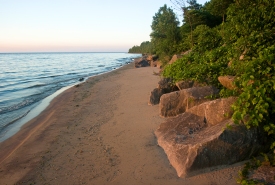Western Lake Erie Islands Natural Area

Shore of the Middle Point Woods property, Pelee Island, Ontario (Photo by Sam Brinker, OMNR)
A mosaic of aquatic and terrestrial resources
The Western Lake Erie Islands (WLEI) are an archipelago of 22 islands spanning the border of Ohio and Ontario. The nine Canadian islands support some of the most biologically diverse natural features in Canada, and contain a high density of rare species in Ontario. The WLEI are part of a globally significant Important Bird Area.
Habitat & species
Rare communities within the WLEI include globally rare shoreline and alvar habitats, as well as savannah and forest communities, all of which provide critical stopover habitat for migratory birds and insects, and serve as nesting sites for colonial waterbirds.
The waters of the region are shallow, warm, relatively clear and high in nutrients, making this the most productive aquatic habitat in the Great Lakes. Currently the Ontario Natural Heritage Information Centre tracks approximately 150 rare or at-risk species from the WLEI area.
Conservation status
Pelee Island is the largest of the Canadian islands, and is the most southerly inhabited part of Canada. The Nature Conservancy of Canada (NCC) has protected over 390 hectares (1,000 acres) on Pelee Island. NCC manages these lands to ensure that the natural habitat that was protected is properly maintained or restored — this is the "forever" part of our work.
The Pelee Island Heritage Centre houses such rarities as the fossil of a 370-million-year-old Devonian fish, while Pelee Island Winery makes ecologically conscious wine right on the Island and is one of NCC's many conservation partners on Pelee.




